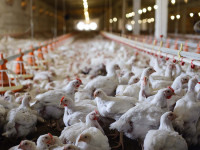Money
Rs1.53 trillion: Ambitious and unrealistic
The financial plan lays emphasis on large infrastructure projects, but reveals little about how it will accomplish them
Sangam Prasain
With an ambitious economic growth target but few tangible bases, Finance Minister Yubaraj Khatiwada presented the federal budget for the fiscal year 2019-20 in Parliament on Wednesday.
The Rs 1.53 trillion financial plan bets on achieving economic growth of 8.5 percent, more bullish than the current year’s target, while generating half a million jobs by the next fiscal year, which begins in mid-July.
“Overall development is only possible through high economic growth and its equitable distribution,” Finance Minister Khatiwada said while presenting the budget. “Our socialist goal is to fulfil the basic needs, such as employment, food security, basic health and education services, and clean drinking water, for all citizens.”
The budget, which is 17 percent bigger than the current plan, has earmarked Rs 957 billion for recurrent expenditure, Rs 408 billion for capital expenditure, and Rs 167 billion for financing provisions.
The government has also revised the economic growth target of 7 percent, from 8 percent, for the current fiscal year.
However, some economists were circumspect about the government’s new growth target, calling it “overly ambitious” with there is no reliable basis presented in the budget.
[Read: Government revises tax structure and changes income tax slab for salary earners]
“An early forecast has shown a below-average monsoon in key crop-producing areas, which means that agricultural output growth, the key sector for economic growth, will lower in the next fiscal year,” said Chandan Sapkota, an economist.
Sapkota conceded that the industrial sector may grow at a faster pace and that post-earthquake reconstruction may pick up in the final phase, which could lead to higher growth. Similarly, the hydroelectricity capacity is expected to double and manufacturing activities may improve on the back of a stable and adequate supply of electricity, he said.

Wholesale and retail trading and tourism activities will support service sector growth. But, despite this, an 8.5 percent growth is “unrealistically ambitious”, he said.
Among a string of ambitious plans and targets, the budget plans to tame inflation in the upcoming year at 6 percent, which some analysts called “questionable”.
The manner in which the real cost of living has increased has not been reflected in the Nepal Rastra Bank’s inflation rate, said former finance minister Ram Sharan Mahat.
“According to the Rastra Bank, the inflation rate for the first 10 months of the current fiscal year is less than 5 percent, which is too low,” said Mahat. “We suspect data manipulation.”
In what is being called a “populist” budget, which largely revolves around the 2017 election manifesto of the ruling Nepal Communist Party, the salaries of non-gazetted officers have also been hiked by 20 percent and those of gazetted officers by 18 percent. The budget has earmarked Rs 64.50 billion for the social security scheme, under which the monthly allowance for the elderly has been increased by Rs 1,000 to Rs 3,000. The scheme is expected to benefit around 1.3 million people above the age of 70, the finance minister said.
[Read: Senior citizens welcome increase in allowance, but say they are not fully happy]
Similarly, allowances for widows and single women have been increased to Rs 2,000 from Rs 1,000.
The budget has also allocated Rs 220 million to provide air transport facilities for pregnant women and has further promised to provide access to clean drinking water to 92 percent of the population by the next fiscal year.
The budget is designed to placate dissatisfied members of the Nepal Communist Party who were batting for more discretionary funds and for the party to adhere to its election manifesto, Sapkota said. That is the primary reason the budget has focused on increasing cash-based social security allowances.
However, Sapkota said that the social security schemes envisioned have a positive side as the government has committed to bringing all such assistance under one umbrella framework.
The Prime Minister’s Employment Programme will continue into next year with an allocation of Rs 5 billion. Another ambitious scheme is the revitalisation of the ‘Afno Gaun, Afai Banau’—let’s build our villages ourselves—programme, which was first introduced in 1994 by the late Communist Party leader Bharat Mohan Adhikari.
The biggest allocation this year has been to the education sector, which gets Rs163.76 billion, followed by roads, infrastructure and railway transportation at Rs163.52 billion. But still, the communist government has failed to implement its promise of increasing the budget for the education sector to 20 percent. The budget for the education sector is around 10.68 percent of the total budget, slightly higher than the current fiscal year, which is 10.20 percent.
[Read Education gets 10.68pc of budget share, half of what government had pledged]
Infrastructure promises
The budget envisions a number of reforms to implement large-scale projects more effectively, as many projects have been bogged down by delays and controversies. As the performance of many contractors for large projects has been found wanting, another change announced in the budget was the appointment of project chiefs from outside through open competition. The financial capacity of the contractors will also be looked at before awarding the project contract, said Khatiwada.
The capital budget has been increased significantly for national pride projects, such as Upper Tamakoshi, Budhi Gandaki and Budi Ganga hydroelectric projects; the Rani-Jamara-Kulariya and Bheri Babai irrigation projects; Nijgadh, Bhairahawa and Pokhara international airports; Kathmandu-Tarai expressway; Postal and Mid-Hill highways; and the East-West Electric Railway Line.
While Rs141 billion has been allocated for post-earthquake reconstruction, Rs83.49 billion has been allocated for the energy sector, Rs68.78 billion for health, Rs40.73 billion for urban infrastructure and housing, Rs34.80 billion for the agricultural sector, and Rs23.63 billion for irrigation.
The budget has allocated Rs 8 billion for the Prime Minister’s Agriculture Modernisation Project and has increased state subsidies on chemical fertilisers by 50 percent to Rs9 billion. Similarly, Rs950 million has been allocated for subsidies to encourage sugarcane farmers. The government announced the enforcement of anti-dumping tariffs for imports on agriculture products.
[Read: Allocation of Rs 60 million to parliamentarians for their constituencies draws public ire]
The Sunkoshi Marine Multipurpose Project has been allocated Rs2.05 billion while the second phase of the Melamchi Water Drinking Project has received Rs7.49 billion for the next fiscal year.
The budget has promised that 1,000 MW of electricity will be added to the national grid in the next fiscal year, along with a new, ambitious project to generate 3,500 MW of electricity from a combined 18 projects by raising funds from the public under the slogan ‘Nepal ko pani, janta ko lagani’.
The Oli administration has announced that each province will be connected by at least two highways and all district headquarters will be connected by road networks by the next fiscal year. Currently, only two districts remain to be connected by road networks.
Construction of the Nagdhunga tunnel has received Rs 6 billion in budget allocation while promises have been made to construct 200 bridges and the completion of the Nepal-China railway in two years, following a detailed feasibility study. The government also said the next fiscal year will see the implementation of biometric national ID cards. The Tribhuvan International Airport will also be transformed into a ‘boutique’ airport and will start 24 hour operations from the coming fiscal year.
Such a large budget allocation to infrastructure is good, said Mahat, but it cannot realistically be implemented.
[Read: The federal budget is out, and the government has disappointed yet again]
The budget has announced raising Re1 from every litre of petrol and diesel as infrastructure tax to finance road projects.
Currently, the government has been levying infrastructure tax of Rs5 from each litre of fuel to fund to the construction of Budhigandaki Hydropower project. Around Rs30 billion raised for the hydel project, however, has remained largely unutilised.
Ambitious, but unrealistic
To fund expenses for the next fiscal year, Khatiwada said the government is planning to raise Rs981.13 billion in tax and non-tax receipts. Rs57.99 billion will come through foreign grants while the resulting deficit of Rs493 billion will be financed through foreign loans of Rs298 billion and domestic loans of Rs195 billion.
Analysts were cautious about welcoming the budget, pointing to its ‘populist’ nature and the lack of tangibles to support what seems like an unrealistically high goal.
The government has envisioned the creation of half a million jobs next fiscal year, but there is no proper way to document how many jobs will be created by the public sector and their nature.
“The government makes this high-sounding commitment pretty much every year, but it doesn’t elaborate how it is going to meet the target,” said Sapkota.
“This was an opportune time to consolidate social security schemes, streamline scattered and incoherent projects, and enhance the efficiency of capital spending and bring structural changes in agriculture, labour and industrial markets,” he said. “However, these were overshadowed by the urge to bring out a distributive and populist budget.”
Related to the story:




 7.12°C Kathmandu
7.12°C Kathmandu













%20(1).jpg&w=300&height=200)
